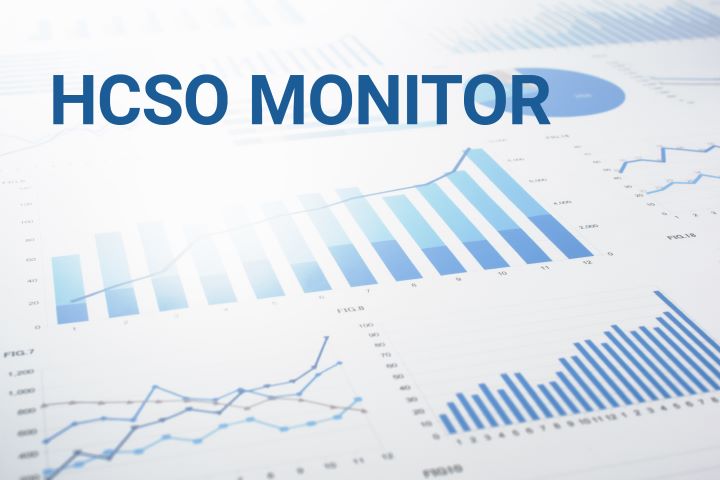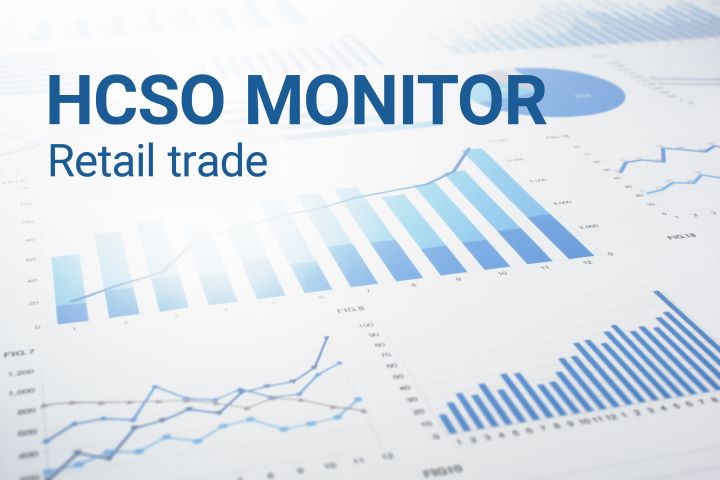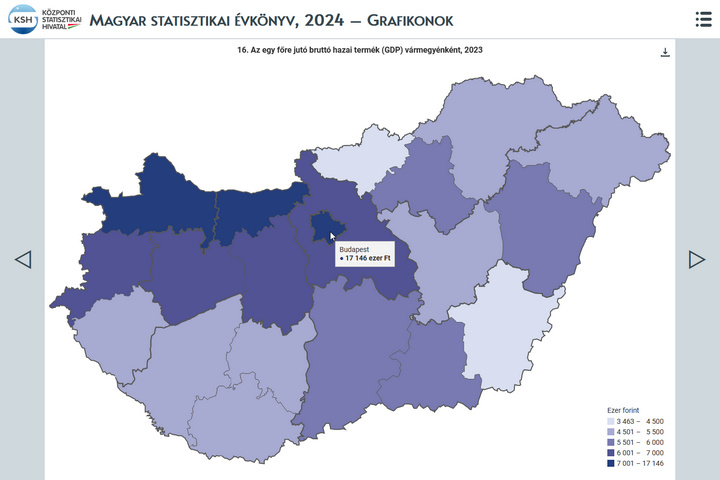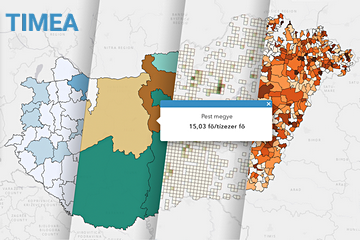Internal trade
Trade is the resale of purchased goods without conversion, an activity that links production to consumption. Trade in goods contributes to the efficient functioning of the national economy, the efficient use of resources, and the return on investment. During buying and selling, the goods purchased from producers are stored, stocked and then sold to users. Statistics on internal trading establishments include the number of internal trading establishments operating in Hungary. Another area of internal trade statistics shows the following: domestic retail sales and volume changes in domestic retail sales.
Key figures
Share of trade and motor vehicle repair in gross value added
Indicator description
Internal trade and repair of motor vehicles as a share of gross value added at basic prices of the national economy in a given year, calculated at current prices.
Source of data:
Summary Tables (STADAT)
Last data for period: 2024
Number of retail stores
Indicator description
Number of retail units operated in Hungary either in a licensed form or after registration.
Source of data:
Summary Tables (STADAT)
Last data for period: 30.06.2025
Volume change in sales in retail stores
Indicator description
Volume change in retail store sales compared to the same period of the previous year, adjusted for working-day effects.
Source of data:
Summary Tables (STADAT)
Last data for period: October 2025
Changes in the volume of sales in specialized and non-specialized food shops
Indicator description
Changes in the volume of sales in specialized and non-specialized food shops compared to the same period of the previous year, adjusted for working-day effects.
Source of data:
Summary Tables (STADAT)
Last data for period: October 2025
Featured
HCSO Monitor
The collection of interactive figures provides up-to-date information on the latest domestic and international socio-economic trends. The decisive part of the figures included in HCSO Monitor are downloadable in both image and data formats (PNG, SVG and CSV). Feel free to browse the data in HCSO Monitor, updated many times a week!
Retail sales were 3.1% up on the same period last year and 0.5% up on the previous month; Retail trade, October 2025
In October 2025, the volume of retail trade in both raw and calendar-adjusted data was 3.1% higher than in the same month of the previous year. Compared to the same period of the previous year, calendar-adjusted sale volumes expanded by 1.2% in specialized and non-specialized food shops, by 5.2% in non-food retailing and by 0.6% in automotive fuel retailing. According to seasonally and calendar adjusted data, the volume of retail sales was 0.5% up on the previous month. In January–October 2025, the volume of sales – also according to calendar adjusted data – was 2.9% higher than in the corresponding period of the previous year.
Smoke-Free World Day, 20 November 2025
The idea of the smoke-free day started in the 1970s in the United States, with the goal of helping smokers in quitting. Due to the American success a smoke-free day is observed every year around the world on the third Thursday of November. The proportion of smokers in Hungary is still above the EU average. Sale of tobacco products had a 6.7% share in our domestic retail turnover of 2024. The import of tobacco and tobacco substitute products is greater than their export within the external trade.
Hungary 1st semester of 2025 – Diverging economic impacts
The performance of Hungary’s economy was identical with the one of the same period of the previous year. The increasing performance of the services sector and consumption growth had a positive impact on GDP. These impacts however have been eliminated by the setback of the industry and agriculture, the continuously subdued investment activity and the deterioration in the balance of the external trade in goods. Retail trade volume continued to rise, tourism nights spent at accommodation establishments also increased in number.
The 1956 revolution and freedom fight
October 23, 2025, marks the 69th anniversary of the 1956 Revolution and Freedom Fight. Due to the military actions, approximately 9% of all retail shops in Hungary (25,000 shops) suffered damage to some extent—predominantly in the capital—with nearly 200 shops rendered unusable. Retail turnover between October 1 and December 15, 1956 (HUF 12.4 billion), exceeded that of the previous year by more than one-fifth, which was primarily due to an increase in purchases by the rural population.
Statistical Yearbook of Hungary, 2024
The yearbook provides an overview of Hungary's demographic, social and economic trends, environmental characteristics and their changes over time, with the help of tens of thousands of data in some 500 tables, charts and maps. In the chapter devoted to earnings and incomes, it is a novelty compared to previous years that net earnings in which allowances and types of exemptions are accounted for, too, came into focus from 2019. In the number of employees, people working in working time shorter than 60 working hours per month are also taken into account. In addition, the theme of environment is completed with areas declared world heritage sites by UNESCO.
Yearbooks, pocketbooks, data repositories
A new sub-page has been added to the HCSO website, more than 400 yearbooks, pocketbooks and data collections, a total of a hundred thousand pdf format pages close to 150 thousand excel tables and several thousand static and interactive graphs and maps are available for download. The sub-page offers the possibility of filtering these yearbooks, pocketbooks and data collections by reference year, serial name, format (PDF, XLS) and supplements (graphs, maps). Users may compile their own list of publications based on the year- and pocketbooks, data collections, adequate to their interests.
Hungary 2024 – The Sectoral Overview
Our series of infographics, based on the most important data from the Hungarian-language publication Hungary, 2024 provides a comprehensive picture of the social and economic state of our country and the main characteristics of our environment. The next infographic in the series presents the main data of the sectoral overview. The English extract from the publication is available here: Hungary, 2024, and the full Hungarian-language version here: Magyarország, 2024.
Hungary, 2024
Hungary’s GDP increased by 0.5% amid global challenges in 2024. The performance of goods-producing industries lessened, while that of service-providing ones rose, which shows the duality of economic trends. Household consumption picked up, which was considerably encouraged by the purchasing power of earnings growing again with the inflationary wave calming down. Besides, the data series reveal that the level of employment reached another peak.
Statistical Pocketbook of Hungary, 2024
The tables and charts in the latest edition of the Statistical Pocketbook of Hungary provide a comprehensive insight into the development of social and economic trends in Hungary during the year 2024. It aims to provide a summary picture of the country's situation in all possible areas based on preliminary indicators. Within the number of employees, this year's pocketbook also includes employed persons working less than 60 hours, and the gross revenues at tourist accommodation establishments.
Snapshots, 2024 – Retail trade
In 2024, the calendar-adjusted volume of retail trade in Hungary was 2.6% up on the previous year: the volume of sales rose by 3.8% in specialized and non-specialized food shops, and by 2.5% in non-food retailing, while they fell by 0.8% in automotive fuel retailing. The number of retail stores at the end of June 2024 was 7.0% lower, or 7,000 fewer than a year earlier. The average floor area of shops increased by 4.7% over this period.
On-line purchases
Based on international trends, the popularity of purchases on the internet rapidly increases in Hungary as well, more and more people recognise its advantages and take advantage of this. 56% of households placed an order on-line in the 4th quarter of 2024, and they spent an average 84.7 thousand forints in making purchases on the internet. E-buyers most often purchased articles of clothing and shoes (64%), which was followed by electrical goods (48%), the administration of overheads payments, and of various finances (42%), as well as the order of household equipment (31%).
Related themes
Methodological information
First releases |
Latest release | Next release |
|---|---|---|
| Retail trade, October 2025 | 04/12/2025 | – |
Dissemination database ( infra-annual data annual data ) |
Latest update | Next update |
|---|---|---|
Distributive internal trade units | ||
| Internal trade units | 14/11/2025 | – |
| Internal trade units | 16/12/2016 | – |
| Internal trade units | 09/09/2016 | – |
| Internal trade units | 09/09/2016 | – |
| Internal trade units | 09/09/2016 | – |
Retail trade turnover by groups of shops | ||
| Sales of retail shops by type of shop (2021 = 100.0) | 04/12/2025 | – |
| Sales of retail shops by type of shop (2015 = 100.0) | 06/02/2024 | – |
| Sales of retail shops by type of shop (2015=100.0) - second estimate | 05/12/2019 | – |
| Sales of retail shops by type of shop (2015=100.0) - first estimate | 05/02/2019 | – |
| Sales of retail shops by type of shop (2010=100.0) - second estimate | 22/02/2018 | – |
| Sales of retail shops by type of shop (2010=100.0) - first estimate | 05/02/2018 | – |
| Sales of retail shops by type of shop | 25/02/2013 | – |
| Sales of retail shops by type of shop | 03/07/2009 | – |



















